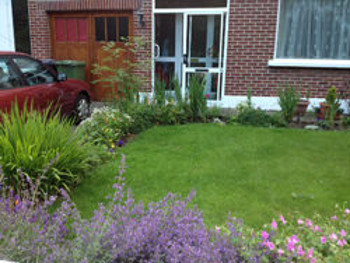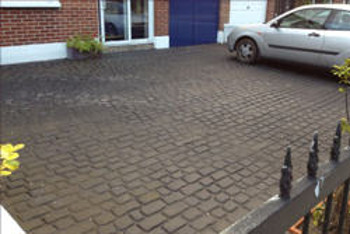What is the result of this cementing over of once green earth?
When my family came to Dublin forty-five years ago, the back garden of the house they moved into was a bare place. The estate was relatively new and the garden, like the others surrounding it, was enclosed by three ugly cement-block walls, with a few small saplings and a failed attempt at vegetable growing in one corner. Now, almost half-a-century later, all the gardens are lush with trees and shrubs and overgrown bushes. A green corridor at the back of the houses is home to a thriving animal and bird life. The unpromising saplings grew into tall trees and now birds nest in the branches. Squirrels live its hollows and foxes slink along the back walls after dark and make homes in the quieter gardens. The gardens have become a haven for wildlife.
 Old style garden The front gardens of these houses, however, are a different matter. The original residents have aged with their properties and are departing for their just rewards. The new, young owners renovate and expand and this expansion includes the paving over of the front garden to make way for the second car. The lawns are dug up and replaced with cement and gravel or neat paving or worst of all, a wall-to-wall, tar-black layer that resembles bubble-wrap. Even gardens in cul-de-sacs get the makeover treatment.
Old style garden The front gardens of these houses, however, are a different matter. The original residents have aged with their properties and are departing for their just rewards. The new, young owners renovate and expand and this expansion includes the paving over of the front garden to make way for the second car. The lawns are dug up and replaced with cement and gravel or neat paving or worst of all, a wall-to-wall, tar-black layer that resembles bubble-wrap. Even gardens in cul-de-sacs get the makeover treatment.
And what is the result of this cementing over of once green earth. Well, there are a number of outcomes. First is the effect on birds. The loss of greenery results in a loss of habitat. The disappearing grass means the end of the insects and grubs that live in and off it and consequently the end of a food source for the birds.
Every year, we lose more and more green space in out cities and town and consequently, a loss of natural drainage. This loss is one of the causes of the increased incidents of flooding we have experienced in that last number of years. The paved area cannot soak up the rainfall anywhere near as fast as the grassy areas resulting in run-off into drains which are unable to cope with the extra water in times of storms. Modern development has not helped through the practice of dispensing entirely with a grassed area in front of the new builds.
 Paved garden Finally, there are aesthetic reasons for not paving over our grass. Gardens make for pleasant spaces in our increasingly cement-built urban areas. They can be an oasis of peace and a feast for the eye of the passer-by.
Paved garden Finally, there are aesthetic reasons for not paving over our grass. Gardens make for pleasant spaces in our increasingly cement-built urban areas. They can be an oasis of peace and a feast for the eye of the passer-by.
It’s in all our interests to think twice about getting rid of the green space at the front of the house and for the local authorities to increase and enforce the planning regulations governing garden development.
I would love to hear your views and opinions on this subject because it affects us all. Please leave a comment.
Rose Comiskey